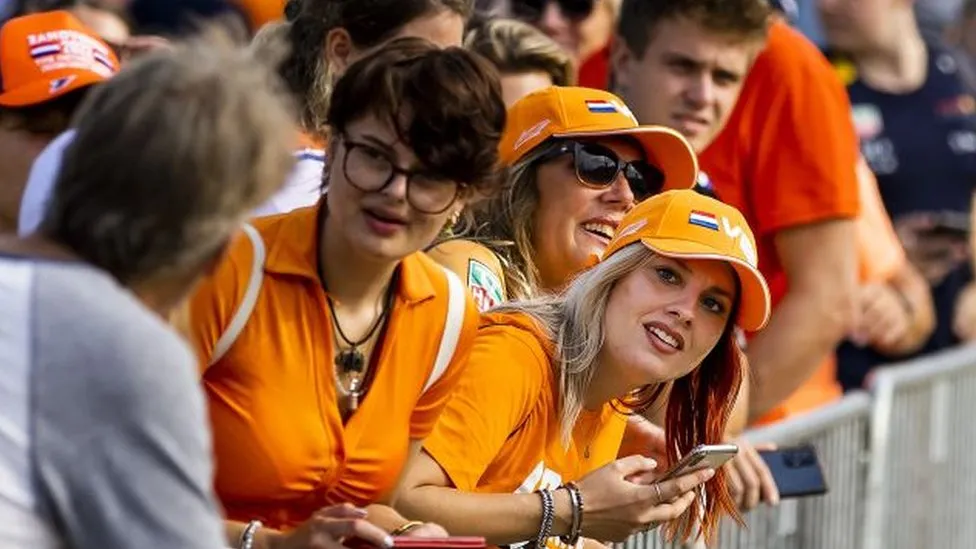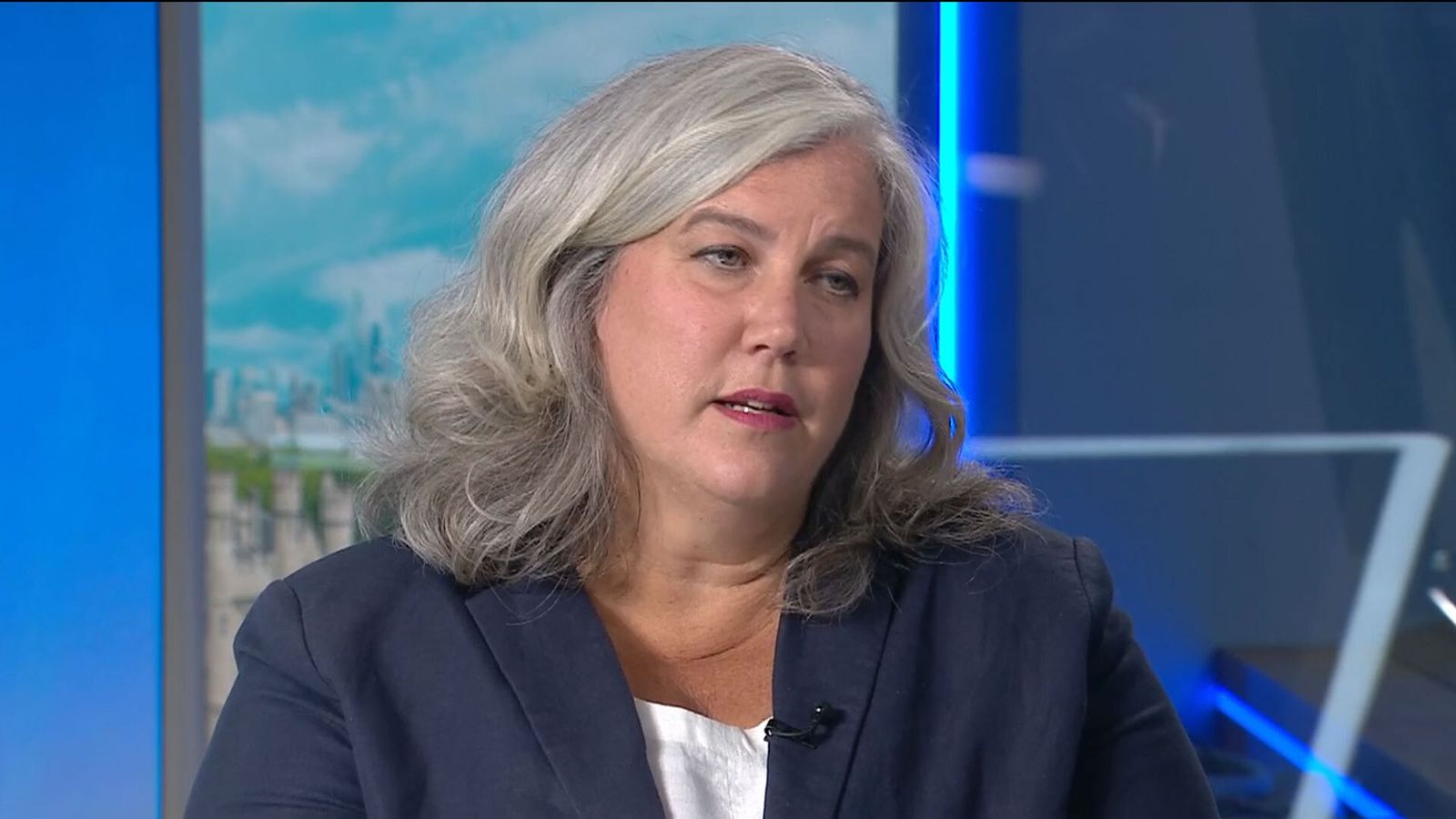Dutch Grand Prix 2023: Zandvoort imposes car ban on travelling F1 fans
The Dutch Grand Prix is a petrolhead event minus the petrol - but with plenty of bicycles.

The Formula One (F1) event is taking place in a tiny coastal town which is locked down to visitors' cars for the entire weekend, with many fans arriving by bicycle.
Perched atop a ladder on the edge of the train platform, a man dressed head to toe in orange directs processions of F1 enthusiasts arriving in Zandvoort.
We're funnelled up steps and through a narrow walkway.
Streets leading from the train to the track are decked out with orange bunting and many of the residents have set up makeshift bars, providing tunes and cold drinks from their verandas.
This weekend, Zandvoort, with its modest 17,000 inhabitants, is welcoming approximately 300,000 visitors.
A self-proclaimed orange army trundles through the streets and dunes, propelled by pedal power and the prospect of seeing homegrown hero Max Verstappen in action.
The only driving within the boundaries of the small seaside community this weekend will be done by residents and authorised event-related traffic. Even the police, paramedics and security are patrolling on bicycles.
The Dutch event aspires to be the most sustainable on the F1 calendar. Almost a third of supporters are expected to arrive by public transport, a third by bicycle or scooter, and the rest will travel by foot, coach or cab.
A train every five minutes is running between Amsterdam Central and Zandvoort, and a fleet of electric buses ferries fans to stops just outside the paddock.
I caught the "Max Express" into the town from Haarlem.
Thousands of bike parking spaces have also been provided, and even officials from the top F1 teams are hopping on the saddle to whiz around the periphery.
Outside the entrance, friends Zoë and Amber are leaning against railings, cameras poised, hoping to catch a glimpse of local legend Verstappen.
"It's mostly for Max," Amber explains. "But I also just love the feeling here, it's like a big party... a festival and we all are one."
"And the noise, so loud," her friend Zoë chips in. "You're almost deaf afterwards but it's worth it."
Amber attempts an impression of an F1 car passing, the distinctive roar of an internal combustion engine evokes an emotion and energy that drives supporters' love of the sport.
But the teenage fans recognise the need for the sport to clean up its act.
Amber travelled to the event by train. "No matter where you are in the Netherlands, you can travel here by bike. Having green credentials is making people aware, we are trying to make things better."
"Orange is the new green," she adds.
Zandvoort has been praised by F1 CEO Stefano Domenicali for delivering "fresh air", and helping to set a precedent for modern era Grand Prix events.
The sport is under pressure to cut its climate impact. According to the industry's own statistics, in 2019 it accounted for approximately 256,000 tons of CO2 emissions - the equivalent of a small nation.
There's a goal, to achieve climate neutrality by 2030, but many, including the German driver Sebastian Vettel, have claimed the fast-paced industry could afford to accelerate on the sustainability front.
Efforts are being made to reuse, repurpose and recycle race materials, provide solar panels and water refill stations in the paddock. Fans in Zandvoort show me a token the size of a coin: if you bring the empty can or bottle back to be recycled, you get a token to secure a discount on your next drink.
But the real challenge lies with travel logistics beyond the racecourse, which account for two-thirds of F1's carbon footprint. A crammed calendar featuring 23 races in the 2023 slate won't help to curb those figures.
In terms of switching to electric vehicles or alternative biofuels, initial experiments have proved promising but limited.
And one part of Zandvoort that won't be green is the race itself.
Gallons of petrol will be burned on the track, nestled between the Dutch North Sea coast and an expansive nature reserve, some 15 miles (25km) west of Amsterdam.
Environmentalists recently lost a lawsuit to stop races at the picturesque circuit. In a plethora of cases, activists demanded that permits for the expansion be overturned, asserting that builders had destroyed sensitive dune reserves where the rare natterjack toad and sand lizard live and breed. They also said that activities at the track throughout the year caused considerably more pollution than the organisers acknowledged in their applications for permits.
Their cases had been dismissed by a lower court in 2021, and in July, the Supreme Court ruled that there was no legal justification to reverse this ruling. However, the court recommended that provincial authorities reassess the concerns of the activists in considering whether the circuit would need a new environmental permit in the future.
A sea of orange, punctuated by black and white chequered leggings, and the colours of the Dutch flag pave the route back to the train station.
Considering an estimated 95,000 fans attended on Friday, the fact there seemed to be a seat for everyone on the train suggests the mobility plan is working.
Sustainability measures promoted by the Dutch prove that tracks can do more to preserve the environment without sacrificing profits or pleasure. And that may encourage countries without an existing embedded cycling culture and infrastructure to accelerate investment to support greener ambitions.
-bbc







